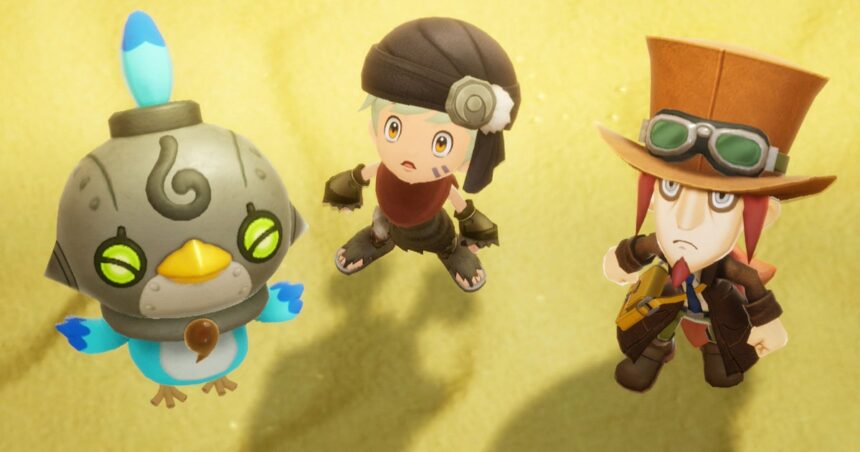What a strange and wonderful game. It took me about four hours to pin down what Fantasy Life is, because by turns it’s Animal Crossing and then it’s a role-playing game, and then it’s something else. The form of the game shifts and shimmies during the opening hours as a constant stream of new ideas are introduced, and it’s only as they begin to settle that you begin to appreciate what an intoxicating blend it can be.
Officially , Fantasy Life i is a life sim RPG, which broadly means – and you’ll know this if you’ve played Fantasy Life on 3DS of course – that you can play many roles within the game, many Lives, as they’re known. You can be a carpenter, a blacksmith, a mercenary, a paladin, an alchemist, a spellcaster, a tailor and so on. There are many Lives to choose from. But the crux of this is you don’t have to choose only one of them. If you want, you can be them all.
You can be out adventuring as a mercenary, wielding a big sword and wearing your mercenary kit, then switch instantly to being a woodcutter the moment you approach and interact with a choppable tree. It’s similar when approaching a workbench, as your carpentry Life takes over and woodworking skills kick in. The same is true of every Life skill you learn: once you’ve got them – and there’s a little tutorial to-and-fro involved in getting them (which you can skip if you know what you’re doing) – they will be available wherever you go, whenever you need them. It’s a surprisingly liberating system.
Why would you want so many Lives, though? Firstly because the game encourages you to have them, either through main quests or villager-given quests on the island, but also because being a woodcutter and being able to source your own wood for your carpentry Life makes sense, just as mining your own ore as a blacksmith makes sense too. But Fantasy Life i takes this a step further, in terms of motivating you, by also being a go-out-and-adventure kind of role-playing game, meaning you’re not always stuck in town, wandering around.
The story is convoluted but it involves travelling backwards and forwards in time to an island that’s either resplendent and filled with life, or destroyed, depending on whether you’re in the past or the present. A thousand years ago, the island was vibrant and populated by an eccentric cast of villagers, who you’ll slowly get to know – and some are genuinely very amusing – whereas in the present, there’s no one around. It’s in these past and present futures where you’ll build a home and make a life, but that’s not all there is to Fantasy Life i.



There is a wider game to explore that goes as far as other worlds, and it’s one of these, Ginormosia, that you’ll keep coming back to. This place is massive and much more closely resembles the kind of adventuring land you find in a typical action-based RPG (and which will be the basis of the roguelike mode being developed for the game, by the way). It’s the sort of place with zoned biomes and packs of enemies that gradually increase in strength, and even towers and shrines to unlock that do similar things as in the recent Zelda games – reveal nearby locations, or offer puzzles.
In Ginormosia, your combat skills will be of particular use, and you’ll obviously benefit more heavily from whatever better-quality armour and equipment you’ve made or acquired. But there’s no way you can tackle Ginormosia in one go: it will take several nibbles over the course of the game, as each time you go away and level-up a bit, and equip-up a bit, and then return. This is where Fantasy Life i finally starts to come into view, in how it presents us with two game experiences stretched across our home life and our adventuring life, that compliment each other.
For instance, combat prowess: you can level up in your chosen Life while out adventuring, but you can’t increase your rank without doing jobs for the guild master, who’s back in town. And it’s only by increasing your rank that you can access more powerful skills on your skill tree, and unlock things like charged attacks, better combos, and various passive abilities, all of which make you more deadly or hardy, depending on what you want to do. It’s a similar deal for crafting abilities – yes they have skill trees too. So you see that you might want better combat abilities and equipment for your adventures, but in order to get them you’ll have to pursue several different Life paths at home first.


.jpg?width=690&quality=70&format=jpg&auto=webp)
That might sound laborious but there’s an innate joy involved in pursuing them. Take carpentry for example. A mini-game springs into life when you want to make something that involves pressing button prompts as fast as you can in order to successfully craft. It’s a little more complex than that but suffice to say that it’s energetic and fun, which aren’t words I typically associate with crafting systems in games. Even chopping trees or mining ore are enjoyable, using ideas like ‘find the sweet spot’ to alleviate the boredom, whereby if you hit a sweet spot, you can greatly increase the speed you take a node down. Couple this with powerful buffs from food or potions and you can smash through resource nodes in seconds. And now you probably want to learn alchemy in order to achieve this. Do you see how it goes? One thing encourages another.
It’s as you start to nose through the skill trees in the games and overlap the Lives you’re living that Fantasy Life i really gets a hold of you, and because it’s so broad, it manages to satisfy a lot of game urges in one. Do you want to build and decorate a home like you do in Animal Crossing? That kind of peaceful island life exists here. Do you also want the thrill of adventure and story and combat?
That kind of experience exists here too. It’s a clever blend and a clever studio that can knit them together and make them work. There’s much more to Fantasy Life i than meets the eye and, for me, it’s one of the stars of the Switch 2 launch.
A copy of Fantasy Life i: The Girl Who Steals Time was provided by Level-5.






